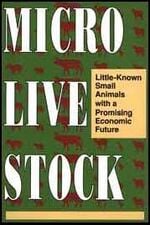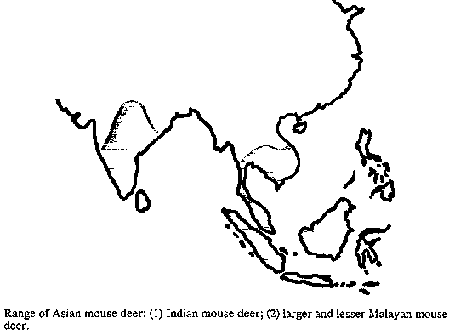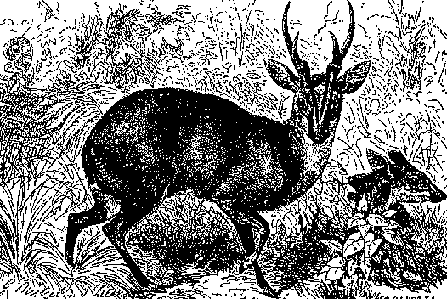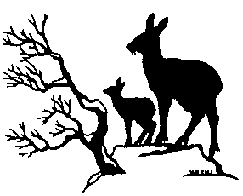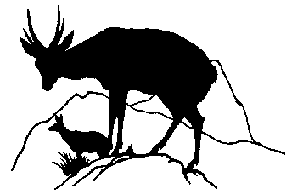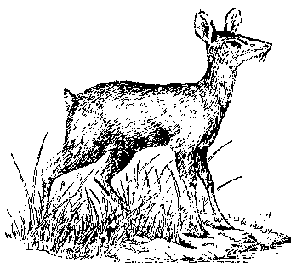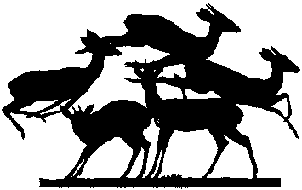Part V: Deer and Antelope[edit | edit source]
Several types of tropical deer' and antelope are no bigger than an average-size dog. These "microdeer" and "microantelope"2 are the smallest of all ruminants. Although there is considerable experience with rearing and utilizing the larger species, little is known about these miniature ones.
Given research, mouse deer, muntjac, musk deer, pudu, brocket, huemul, and water deer, as well as half a dozen small antelope, might prove to have considerable potential. Collectively, they come from diverse habitats, ranging from equatorial to subarctic and from moist rainforest to arid savanna. They are adapted to some environmental conditions that are only marginal for production of conventional livestock because of drought, heat, diseases, altitude, or other constraints.
DEER FARMING
Deer appear to be unlikely candidates for livestock, but reindeer were probably among the first domesticated animals and have been draft animals for perhaps 2O,OOO years. Even today, tens of thousands of reindeer pull sleighs in the European arctic. On military expeditions, the ancient Romans took along herds of fallow deer as a source of meat, and more than 1,000 years ago deer were annually herded off the Scottish Highlands for winter meat supplies.
In recent years, there have been breakthroughs in the "domestication" of deer. Species already being [armed are: red deer (New Zealand, Australia, Taiwan, Korea, Russia, China, Scotland, the United States), elk (New Zealand, Canada, the United States), fallow deer (New Zealand, Australia, England, Denmark, Sweden, Switzerland, Germany, the United States), ruse deer (Australia, Mauritius, New Zealand, Papua New Guinea), sika deer (Taiwan, New Zealand), musk deer (China, India), and PFre David's deer (New Zealand). Although not truly domesticated, even the moose has been tamed in Scandinavia and the Soviet Union, the calves being bottle-raised from three days of age.
New Zealand has made particular progress in domesticating large deer (see sidebar). It seems probable, therefore, that similar success with small deer could be achieved. For those seeking interesting, pioneering research, microdeer are good candidates.
ANTELOPE RANCHING AND FARMING
The worldwide experiences in domesticating various deer species suggest that the organized production of small antelope should also be considered. Several large species have already been studied and are used in game farming in eastern and southern Africa. Similar research on the smaller species, which so far have received little or no attention, is one of the more speculative ideas in this report. We put it forward only for consideration by researchers, but if exploratory studies prove successful, this is a topic deserving international support.
In some parts of Africa there are large expanses of uninhabited lands, and producing any sort of livestock there is limited by aridity and by the presence of tsetse flies. But in this habitat live tiny antelope such as dikdik, suni, and klipspringer. In the rainforests and secondary forests are found duikers and the royal antelope. All these creatures have advantages that justify their consideration as microlivestock: they have a more rapid turnover than the big species, and they produce a high yield of quality meat. In addition, compared with cattle, these native ungulates make better use of the habitat. Cattle select a limited number of grass species; antelopes choose a wider range, and also include fortes, bushes, and trees.
More important perhaps is their resistance to many diseases. Most, if not all, are resistant to trypanosomiasis, the disease carried by the tsetse fly. They are not immune to this and other tropical diseases, but they are less susceptible than cattle. However, part of this may be owing to their ability to roam widely; if confined and treated like domestic animals, they may also require some protection against parasites and diseases.
Antelopes are also more productive than cattle; that is, they produce a given quantity of meat more quickly because they breed better in the African hinterlands and grow more rapidly on its existing forages. On the other hand, they generally require a richer diet than cattle.
Finally, in their favor, antelopes affect the habitat less than the same density of cattle does; they spread out more while feeding and thereby cause less erosion.
There are two ways of exploiting this potential. One is by "cropping"-taking a controlled offtake from free-ranging populations without depressing the overall population. Several methods for producing meat this way from large antelope have been attempted in countries such as Kenya, Tanzania, and Mozambique. Few have persisted. Often this has been due to opposition from the vested interests of the cattle industry and from stringent veterinary requirements. Nonetheless, game ranching offers a means by which marginal lands could produce food of a high nutritional quality on a sustained basis.
The other method is by farming - that is, domesticating or partially domesticating the animals, keeping them in pens or herding them like cattle. Experiments in farming antelopes have been less common than game ranching, but one of the most interesting is that conducted on the Galana Ranch in Kenya. Three wild species - buffalo, eland, and oryx - were selected for comparison with cattle. Half-grown animals were preferred for capture, and it was found that if they were kept in the dark for the first week after capture, and then gradually provided with more and more space while they became familiar with people, after about six weeks they could be released into the open and herded from place to place. Grazing during the day under the eye of a herdsman, they allowed themselves to be herded back to a pen at night in the traditional African manner, where they would sleep around the campfire. This was a promising advance in behavior modification leading toward domestication. The oryx, for example, gained weight on grazing that would not even sustain cattle, and it required only a quarter of the amount of water.
At bottom, the question is not what contribution antelopes can make to the African larder, for they already make a significant contribution through (largely illegal) hunting. The question is whether farming could make them a sustainable asset rather than their being senselessly squandered, as is the case at present. Although its potential has yet to be realized, antelope farming is not a panacea for Africa's food problems, and certainly not the world's, but it might pave the way to a new and more gentle way to make savannas useful.
TAME GAME
Since the 1970s, deer have taken the place of sheep on many New Zealand pastures, and today the country has more than 5, 000 deer farms carrying over one million head, mainly red deer. It is now common along country roads to see tall fences surrounding graceful deer quietly grazing ryegrass and clover. And there are all the appurtenances for deer that exist for cattle and sheep. Auctions and shows are held regularly. Deer farmers have a professional association and produce their own glossy magazine. Government scientists publish pamphlets on the care and management of deer. There are recognized stud stags, computerized recording schemes for breed improvement, and even veterinary services specifically for deer. Hybridization between wapiti and red deer, and PFre David's deer and red deer, is accepted practice. The animals are moved by use of dogs (which command by mere presence rather than by bark or bite), and herds of up to 80 are shifted by truck. Slaughter facilities specifically for deer are in operation throughout the country.
This transformation of a nervous, jumpy, and retiring wild species into a farm animal is a remarkable achievement. Once accustomed to people, many specimens become gentle, even affectionate, and will come at a farmer's call. Males are generally as easy to handle as females, except during the rutting season when they become aggressive and cannot be handled at all.
However, even at the best of times the farmed deer must be handled gingerly. If the causes of stress are not quickly suppressed, hysteria can erupt throughout a herd; in an instant, quiet animals can be leaping suicidally in all directions, disoriented, diving head-on into fences, charging gates. Chronic stress, the causes of which are not always obvious, can result in illness or death, although this trait diminishes in subsequent generations of farm-born stock.
A deer farm has to be laid out to certain special specifications. To prevent escapes, the boundary fences must be 2 m high with netting of 15- or 30-cm mesh. Inner fences need only be 1.5 m high. Water troughs are placed in the middle of the fields, and nothing is allowed to jut inwards from the fences because the animals tend to walk fencelines and take comfort from the illusion of openness. Because deer like to wallow in hot weather, some farmers also provide shallow waterholes.
Deer yards can be of any design, but the sides of the passageways and holding pens should be solid, as deer do not see fences very well, particularly when under pressure, and may injure themselves in a leap towards what appear to be wide open space. (New Zealanders usually make the sides of plywood.) Also, the holding pens should be roofed, as semidarkness has a calming effect. Animals that in the sunlight become hysterical on seeing a person in the distance, can, in the relative darkness of a roofed shed, be touched and even given injections.
Despite the special facilities, however, handling deer takes time and care and experience. The most successful farmers spend much time among the deer so that the animals become accustomed to human presence. This helps to make yard work easier. Also, new arrivals are allowed to wander through the yards on their own to become familiar with them. In addition, special tame deer are used as leads or decoys to encourage the rest of the herd to follow. Using such simple techniques, a formerly intractable species has become almost fully domesticated.
26 Mouse Deer[edit | edit source]
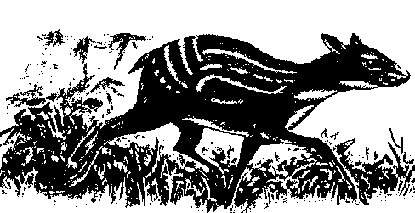
Mouse deer1 (Tragulus spp. and Hyemoschus aquaticus) are among the smallest ruminants known. The lesser mouse deer of Southeast Asia is probably the smallest; an adult stands only 20 cm high and weighs a merc 1-2.5 kg.
Although they look vaguely like tiny deer, mouse deer differ in several particulars. The stomach is simpler and (like the camel's) has three instead of four effective compartments. Rumination occurs, but mouse deer are the most primitive of all ruminants. Indeed, they share a number of characteristics with nonruminants, including lack of horns or antlers; continually growing, tusklike upper canines in males; sharp-crowned premolars; and four fully developed toes.
Virtually unchanged in 25 million years of evolution, these are solitary, nocturnal, retiring animals that have seldom received detailed research. Whether they might make suitable microlivestock is unknown. However, they seem to be tractable, and people in Southeast Asia (Sarawak, for instance) have traditionally kept at least one of the species as backyard pets. Moreover, mouse deer are indigenous to tropical lowland regions and withstand the heat and humidity that are stressful to most conventional livestock species. They probably also are resistant to many diseases of those torrid regions.
In the United States, mouse deer are being raised as laboratory animals for basic research on ungulates. This is because the animals are easier to handle than large deer or goats.2
APPEARANCE AND SIZE
Mouse deer are graceful, lithe, and look somewhat like large rodents. The Asian species are the shape and size of an agouti (see page 198); the African species is more like the pace (see page 262). All have short legs, a small head, and a pointed snout. Adults weigh from 1 to 5 kg, depending on species. The head and body are only 04-1 m long, and the shoulder height is merely 20-36 cm. Males are generally smaller than females.
In most species the body is a rich brown with white spots and stripes. The belly is usually white. The animals stand on the middle toes, so that the lateral ones do not touch the ground. Neither sex bears antlers. In males the upper canines form long tusks that may extend outside the lips and even to below the line of the jaw.
DISTRIBUTION
Twenty-five million years ago, early forms of mouse deer existed throughout Asia, Africa, and Europe. Today's species are restricted to tropical forests and mangrove thickets of Southeast Asia and Central Africa.
Of the three Asian species, the Indian mouse deer occurs in southern India and Sri Lanka; the larger Malayan mouse deer occurs on the mainland of Southeast Asia and the lesser Malayan mouse deer occurs on Java as well. The water chevrotain, a related African animal, is found from eastern Zaire to the Atlantic coast.
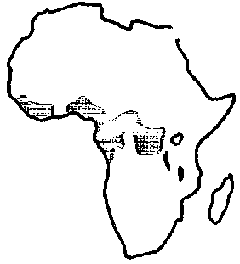
STATUS
In recent years, human encroachment into the forest has caused the destruction of the mouse deer habitats and has put various mouse deer species under a pressure that is causing their populations to decline.
HABITAT AND ENVIRONMENT
These animals inhabit equatorial forests and mixed secondary tropical forest. They generally live among undergrowth on the edges of dense lowland rainforests. They especially haunt rivers and swampy bush areas, seeking escape by water when in danger.
BIOLOGY
Little about these animals is recorded. Essentially vegetarians, they feed chiefly on fruits, supplemented by leaves. They also eat insects (for instance, ants), if available. They do not seem to eat grass.3
The premolars of the mouse deer are designed for piercing and chopping food rather than for chewing. As noted, the stomach consists of three functional compartments: the rumen, the reticulum, and the abomasum. (The omasum of ruminants is represented only by a rudimentary area.) The stomach occupies almost the whole of the abdominal cavity, extending from the diaphragm to the pelvic inlet, which provides this small animal with large food-storage capacity.
The blood has a very high erythrocyte (red blood corpuscle) count as well as the smallest erythrocyte size of any mammal. The flesh is "white" and the muscles contain little myoglobin.
Mature females reproduce almost continuously, and usually regardless of season. In the female larger Malayan mouse deer, mating occurs within 2 days of giving birth. In the African species, many births are synchronized with the rainy seasons, when fruits are plentiful. The gestation period is about 5-6 months, depending on the species. There is only one young per birth. Weaning normally occurs at 2-3 months, but can occur as early as 3 weeks, with sexual maturity achieved at 4-5 months (Asian species) and 10 months (African species). The young stay alone, hidden in vegetation during the first month or two.
BEHAVIOR
Mouse deer are shy, keeping to dense jungle and depending on concealment for protection. Although often present in large numbers, they are seldom seen. Preferring to be near lakes, rivers, or streams, they can nevertheless wander I km or more from water. They feed mostly at dusk or at night, sheltering in undisturbed areas or under shady bushes during the day. They utter weak, bleating sounds, and when frightened, jump a meter or more in the air.
Communication is by scent and calls. The African species possess anal and preputial glands, with which, along with urine and feces, they mark their home ranges. Males of both Asian and African species possess a chin gland to mark either the vegetation or their mates.
Mouse deer are among the most excitable, nervous, and jumpy animals. One must tread softly in their presence for fear of causing absolute pandemonium and mishap.
USES
Mouse deer are widely sought by native people for food, and their meat is highly regarded. Dressed carcasses have a high proportion of muscle (84 percent in Asian species), low proportion of bone (15 percent), and an insignificant amount of fat. The ratio of muscle to bone is large - 5.6:1. The mean dressing percentage of 62.1 percent is greater than that reported for cattle, water buffalo, or goat.5
HUSBANDRY
Adults are wild, generally intractable, and "flighty," but young animals (at least of the Asian species) tame readily and make good pets. Nevertheless, these are delicate creatures and must always be handled gently. Individuals caught in the wild tend to bash against the sides of cages.
Despite an unpromising temperament, Asian mouse deer are regularly bred in zoos, including those in Amsterdam, New York, and Zurich. They also have been reared successfully in small enclosures at several research institutes, such as the I.R.E.T. Institute, Makokou, Gabon; the Institute of Medical Research in Kuala Lumpur, Malaysia; and at Fort Detrick in the United States.
Perhaps the best way to breed this animal is by using the battery system of small units comprising one male and two females per cage. The costs are mostly for obtaining suitable enclosures and for feeding and watering troughs.6 The cages must be covered with mesh because the mouse deer can jump. However, the covering must be sufficiently high to allow the male to stand with its body vertical during copulation.7 They can be fed a variety of foods and grow well on stems of bean plants.
ADVANTAGES
As noted, these are small, seemingly tractable creatures that are at home in the heat, humidity, and diseases of tropical lowlands. They might play a particularly important role as livestock for tropical rainforests; the forests could be left standing while the animal still produces meat. Today, in a widely condemned process, tropical rainforests are being felled in order to raise cattle for meat.
LIMITATIONS
Small size makes mouse deer easy prey for various predators. In the wild, snakes, crocodiles, eagles, and forest cats feed on them.
Mouse deer are among the most excitable, nervous, and jumpy animals. One must tread softly in their presence for fear of causing absolute pandemonium and mishap.
The different species are solitary, and it is difficult to keep many individuals (especially males) in a restricted space. They must be kept in a quiet enclosure, with cover or good shelters.
RESEARCH AND CONSERVATION NEEDS
The survival of these four "living fossils" depends on conserving their rainforest habitat and restricting hunting, especially night hunting. But studies of their propagation and management are also imperative.
In particular, research is warranted on various aspects of their husbandry, such as enclosure design, space requirements, and health. A special research need is to understand the animal's nutritional requirements and to develop diets for use in captivity.
27 Muntjac[edit | edit source]
Muntjac, or barking deer (Muntiacus species), are among the most widespread but least known of all Asian animals.1 They are almost the size of an average dog and they bark, but they are true deer. These little animals adapt well to captivity and have been introduced to zoos and wildlife collections throughout the world.
In recent years one species, the Reeves' muntjac, has become established in England, and a few specimens have settled into semicaptivity - staying behind fences, accepting human presence, and even eating out of people's hands. In Sarawak, villagers have also been known to keep muntjac, feeding them a diet of rice with some leafy matter occasionally added.2 Such experiences show that these small, shy deer can be calm and adaptable. It also shows that they can be raised on practical, artificial diets and that they are not strictly browsers. This creates the possibility (admittedly highly speculative) that they might make future microlivestock.
Muntjac produce lean, palatable venison and perhaps could be farmed on an organized basis. They are native to severe environments where heat, humidity, and endemic diseases make raising conventional livestock difficult. In future, given research, muntjac might become widespread contributors to Asian economic development. The lessons learned in captive breeding could also be important for conserving endangered muntjac species.
One species, the Indian muntjac, has an incredibly low chromosome number (2n=7 in males; 2n=6 in females), which makes them particularly promising candidates for mammalian genetic studies. This species has regularly bred well in both zoos and research institutions.
APPEARANCE AND SIZE
Muntjac are small and slender. Reeves' muntjac, the smallest, has a shoulder height of 45-60 cm. Fully grown, it weighs less than 20 kg; commonly it is merely 10-12 kg. The Java subspecies of the Indian muntjac is the biggest, with a shoulder height of 58 cm and a mature weight of 43 kg.
Antlers on the males usually include a main prong as well as a much shorter brow tine. Even the main prong is no larger than a finger, but its pointed tip is hooked and must be treated with caution. There are also two tusklike canine teeth that protrude from the mouth. These have sharp points and a knifelike posterior edge, capable of cutting to the bone a person's finger or another muntjac's rump.
Coloration varies from deep brown to yellowish or greyish brown with cream or whitish markings, depending on the species.
DISTRIBUTION
Muntjac are native to a vast region from eastern China to Nepal, India, Sri Lanka, and Indonesia.
Almost a century ago, Indian and Reeves' muntjac were introduced to a deer park in southeast England. Some escaped, and (as noted) the Reeves' muntjac has adapted, spread, and settled down to life in the countryside.
STATUS
Of the five muntjac species, the Reeves' and the Indian are well known and in no danger. For instance, recent estimates of annual game production have shown that there are about 650,000 Reeves' muntjac in China. The other three are threatened with extinction. Black, Roosevelt's, and Fea's muntjacs are virtually untried in captivity, but the success of raising Reeves' muntjac in English country gardens suggests that perhaps their populations could be saved through captive breeding.
HABITAT AND ENVIRONMENT
In their native habitats, these small deer are usually found in dense vegetation on hilly ranges at elevations up to at least 3,000 m.3
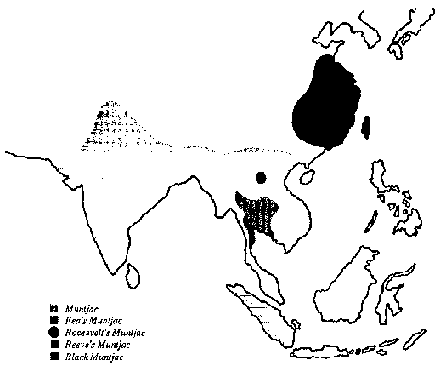
BIOLOGY
Muntjac seem to be primarily browsers. However, in captivity they eat fresh grass, alfalfa hay, and feed pellets. They also readily eat root crops such as potatoes, carrots, and parsnips. They are "concentrate selectors," preferring foods low in fiber and rich in protein and nutrients. Captive specimens reportedly need; a supply of cut browse.
Breeding may occur year-round, but in practice it is synchronized with certain seasons. The first conception can occur as early as 6 months of age. One, occasionally two, young are born after a gestation of about 200 days. They weigh around I kg at birth, and the fawns usually remain hidden until they can move about with the mother. The females mate within a few days of giving birth. Life spans up to 16 years have been recorded.
As noted, the Indian muntjac is a species of great cytogenetic interest. It has the lowest diploid chromosome numbers yet found in a mammal.4 The large, easily distinguishable chromosomes are a great advantage in tissue culture, and many laboratories now have muntjac cell lines. The karyotypes of the different species' chromosomes are very different; the Indian and Reeves' muntjac can hybridize, but the offspring are infertile.
BEHAVIOR
Muntjac are dainty and have a captivating charm. Always on the alert, they are active both day and night. Often they will bark for an hour or more, but typically they bark for only a minute or two. When panicked, captive muntjac may rush into fences or walls. They can easily leap barriers 1.5 m high.
Males are highly territorial and defend their territories vigorously. Adult females also inhabit a specific territory, which they defend against strange individuals.
Males mark the ground at intervals by lowering the head and rubbing the frontal glands on the ground and by scraping their hooves against the ground. They mark trees by scraping the bark with the lower incisors and rubbing the base of their antlers.
USES
In Asia, muntjac are hunted for meat, skins, and antlers.
HUSBANDRY
Muntjac thrive and, at least under ideal conditions, breed freely in captivity. However, they may stop breeding if they are crowded.
In England, zoos and private collections keep as many as six muntjac in an area of 40 x 20 m. Plenty of cover is provided for the animals to hide in. Fences almost 2 m high are used. (Lower fences are reportedly adequate where there is no risk of the deer being panicked by dogs or people.)
ADVANTAGES
Like other deer, muntjac produce extremely lean meat.
They seem to be healthy animals. In Britain, wild and captive muntjac have few gastrointestinal worms, and ectoparasites such as ticks and lice are not a problem.
MUNTJAC
In England, far from Asia's forests and mountains, the Reeves' muntjac is the subject of a peculiar chapter in the otherwise unhappy history of introduced species. Charmed by the deer's odd characteristics, the British have welcomed its invasion into gardens around the country. Now, there are tens of thousands of muntjacs on the loose, and some people have even adopted them as pets.
Although other alien species have wreaked havoc on native plants and animals, muntjacs appear to be a merciful exception. At least over the short term, muntjacs "have proven to be an almost innocuous asset to the countryside. They give pleasure to thousands and pain to few. Eating mostly ivy, grass, leaves, and prickly bushes, they rarely feed in one place long enough to do much damage except to an occasional suburban garden."
Life for many muntjacs is made soft by homeowners who find the deer's large, dewy eyes and tiny antlers irresistible. The kind-hearted suburbanites put out salt licks, water, and kitchen scraps, and they built snug little shelters against the cold north wind. "All our adult deer will take food from the hand," says Walter Buckingham, who has kept muntjacs for five years in his garden in the county of
Hertfordshire, just north of London.
The adaptable immigrant is colonizing new areas so rapidly, say biologists, that soon there may be more in England than in Asia. "In time," predicts muntjac-researcher Oliver Dansie (pictured opposite), "it may eventually establish itself as our most widely distributed deer species."
LIMITATIONS
In the wild these animals are not gregarious and are generally found alone or in pairs. Because of their strong territorial instincts, large males may not be able to be kept together without fighting. The upper canine teeth can inflict serious wounds. Some females are intolerant of each other as well.
Muntjac are fragile; they cannot be held by the legs, for example.
Some infectious diseases may prove to be of epizootic importance: foot-and-mouth disease, mucosal disease, epizootic hemorrhagic disease, rinderpest, and tuberculosis (all three types). This may be a problem, especially when people are raising the animals by hand.
RESEARCH AND CONSERVATION NEEDS
To ensure a better understanding of their potential as microlivestock, muntjac deserve research and recognition from animal scientists and conservationists from Nepal to China. The English experience shows how populations of the endangered species might be built up. At present, however, none are receiving any husbandry research; only the two most common species can generally be found in zoos.
These animals deserve investigation into physiology, reproductive requirements, fertility, nutrition (for example, food preferences, feeding strategies, and food utilization), growth, adaptability and environmental tolerance, diseases, management, social structure, and selection for calm temperament.
28 Musk Deer[edit | edit source]
The musk deer (Moschus species)1 is so small that (like other ungulates in this section) it is only as large as an average-size dog. A gland in males produces musk, a thick, oily secretion that is one of the most valuable substances in the animal kingdom. Musk is used in Oriental Medicine as well as in Europeans perfumes, and in recent year it has sometimes sold for as much as three times the price of gold.
Musk is traditionally obtained by killing these deer and removing their glands. The dried glands, called pods, contain a reddish brown musk powder that has been a commodity in international commerce for more than 1,000 years. Despite bans in India (1972) and Nepal (1973), musk continues to be illegally exported, mainly via Hong Kong, for use in Japan and Europe. In Japan, for example, it is an ingredient in more than 200 different medicines.2 In Europe, musk goes into some of the most famous perfumes.
The international trade in Himalayan musk, originating from both northern and southern sides of the Himalayan divide, amounts to 200 kg per year, representing an annual slaughter of 20,000-32,000 male deer.
The commercial value of the animal makes it highly attractive for development as a livestock species. The economic force causing its slide toward extinction could be employed to protect and restore both the species and its habitat. Ranching these deer might put musk production on a sustainable footing. It might also encourage habitat protection, because in the harsh climate of the high Himalayas, rearing musk deer could be much more profitable to villagers than raising crops or cattle.
Musk deer are already being farmed under primitive conditions in China, where techniques for extracting musk without killing the animal have been developed. In India, small collections of musk deer have been established by the forest departments of Himachal Pradesh and Uttar Pradesh. For several years authorities in Nepal have successfully extracted musk from an adult male at the Kathmandu Zoo' without apparent harm to the animal.3 These experiences suggest that musk might become a farmed product. So far, however, success has been limited. The Chinese animals, for example, have a high mortality rate and the musk is said to be of poor quality. Nonetheless, these examples are valuable pioneering case studies that deserve recognition, support, and further development.4
APPEARANCE AND SIZE
With their long ears, arched back, and bounding gait, these diminutive deer remind one of large hares. The pointed face and large ears make their heads strikingly reminiscent of kangaroos. The coarse hair gives them a stocky appearance. The color varies according to species (and subspecies) from rich reddish brown to dark grey or black. The peculiarly brittle and wavy hair probably has good insulating properties, as it consists of air-filled cells arranged like a honeycomb.
Musk deer have an average mature weight of about 6-11 kg and a body length of 50-90 cm. They stand 50 60 cm high at the shoulder and 5 cm higher at the rump because the hind legs are longer than the forelegs. Some dwarf types are only 40-46 cm high. The tail is short, and in males it is naked, except for a terminal tuft of hair, because they mark their territories by constantly rubbing the caudal gland, which is located near the tail, onto objects.
All four toes are flexible, which, compared to the rigid hoof of other ungulates, gives a firmer grip on precipitous slopes. The dew claws are enlarged and, together with the central digits, splay out, to minimize sinking in soft snow.
Neither sex possesses antlers, but males have long upper canine teeth that project well below the lips. The lower front teeth have a spatulate form that probably helps the animals scrape lichens from the surfaces of rocks and trees in winter, when most vegetation is snow covered.
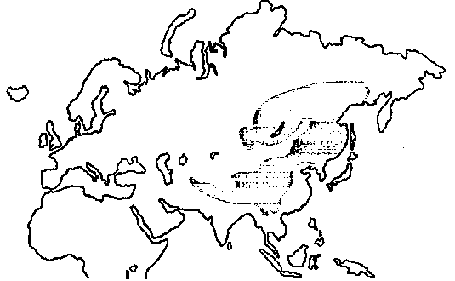
DISTRIBUTION
The genus is distributed patchily throughout the forested mountainous parts of most of Asia. One population extends from just north of the Arctic Circle southward to the northern edge of Mongolia and Korea. Others occur in China, northern Vietnam, and the Himalayan region including Bhutan, Assam, Tibet, the Indian Himalayas, Nepal, and northern Pakistan.
STATUS
During this century, the musk deer has rapidly declined throughout its former regions. In many parts of Afghanistan, Pakistan, India, Nepal, and probably Tibet, it is already regarded as rare, with a distribution that is becoming increasingly localized. Possible exceptions are Bhutan and most of China, where its population is thought to be stable. In southern China, a recent estimate puts the musk deer population at 100,000 head. In western and northwestern China, the population is estimated at 200,000-300,000 head.5
It is the uncontrolled hunt for musk that in most places is driving this animal toward extinction, but its habitat is also being increasingly destroyed by livestock and woodcutters. Part of the loss to hunters is owing to the mindless way in which the animals are caught. Most are snared in traps or nets or killed by poisoned stakes set on trails. This kills all the animals indiscriminately, even females and fawns, which produce no musk. This waste of reproductive animals is extremely destructive to the populations and is senselessly hastening the musk deer's extinction.
HABITAT AND ENVIRONMENT
Musk deer mainly occur in upland woodland and scrub areas. They prefer remote, dense vegetation, especially birch-rhododendron forests in mountainous terrain. They are seldom found in treeless regions or areas thickly populated by people. In the Himalayas, the upper limit coincides approximately with the tree line, which is as high as 4,600 m at the eastern end.6
BIOLOGY
Despite its economic importance and wide distribution, little is known of the musk deer's biology. Nonetheless, it is known that musk deer have a gall bladder, a bovid feature that distinguishes it from the true deer.
The animals are browsers, relying on young leaves, buds, fruits, and flowers. During the winter, as snow deepens, they depend more on lichens growing above the snow on rocks or tree bark, although in shallow snow they scrape for vegetation with their hooves.
The male's musk sac is unique among deer. Situated between the umbilicus and penis, it contains the gelatinous, odoriferous oil. The amount varies with the season and the age of the animal, but pods of adult males usually weigh about 30 g; occasionally up to 45 g.
Males also have a caudal gland under the tail, which secretes a viscous yellow substance with a goaty smell. They mark vegetation with this secretion by rubbing their hindquarters against stems and branches.
Males become sexually mature at about 18 months, but females seem capable of reproducing in their first year. The estrous cycle is 18-25 days; the receptive period lasts 36 60 hours. Gestation varies from 178 to 192 days. Each female usually bears one or two fawns, rarely three. The fawn is precocious - able to stand and move within 15 minutes.
BEHAVIOR
Musk deer are shy, furtive animals with keen senses of hearing, smell, and sight. They are normally solitary and are most active at dawn and dusk. Only under cover of darkness do they frequent the more open spaces. Except in the rutting season, more than two animals are seldom seen together; groups usually consist only of a female and her young. The alarm call, a loud hiss, is often accompanied by a highstepping, springy gait.
In the wild, musk deer lead "orderly" lives. They use well established trails connecting well-established feeding places, resting places, and "latrines" where they deposit their droppings. Migration is uncommon.
Remarkably sure footed, musk deer climb cliffs and even the trunks of leaning trees. Being small and solitary, they rely on camouflage to avoid predators but flee through established escape routes when disturbed. If cornered, males defend themselves by slashing with their tusks, often inflicting deep cuts and severe injuries.
USES
The strong-smelling, reddish-brown musk is obtainable only from this animal.7 It is used as a fixative in expensive perfumes to increase the retention of the fragrance on the skin. In Oriental medicines it is used in stimulants, sedatives, and other products. Some medicinal properties appear to be genuine.8 Recently, highly purified musk has been selling for as much as $27 a gram.
Trade in the Himalayan musk deer or its products is banned by all countries that are parties to the Convention on International Trade in Endangered Species of Wild Fauna and Flora (CITES). However, products from musk deer in the Soviet Union and China can be traded legally under license. It seems likely that if formal, self-sufficient, musk-deer farming projects can be established elsewhere, with safeguards to minimize poaching, a wider trade would be officially sanctioned.
HUSBANDRY
Since at least 1919, Chinese scientists have been experimenting with the extraction of musk without killing the males. When the sexual activity is at its peak, the males are caught and musk removed from the pod with a runcible spoon (curved fork) inserted into the sac's aperture. The procedure takes only minutes. There are records of up to 9 g being recovered at a time.
As noted, China established formal musk deer farms in 1958. They are clustered in the Maerkang, Miyalo, and Manchuan areas of Sichuan Province; the Zhenping county of Shanxi Province; and the Fuziling area of Anhui Province. Despite heavy initial losses of animals, mainly during transportation and acclimatization, the Chinese now breed musk deer in considerable numbers. However, juvenile mortality is still high and longevity relatively short. Zoos in other parts of the world have also had difficulties maintaining the animals.9
In captivity, musk deer readily accept many foods: lettuce, carrots, potatoes, apples, rolled oats, hay, alfalfa, bananas, some grass, bamboo leaves, and pumpkins, for example.
LIMITATIONS
The musk deer's social system may represent an impediment to its successful reproduction in captivity. It is irascible and scares easily. In close confinement, males fight and may have to be isolated from each other.
There is an inherent danger in any captive-breeding scheme in the Himalayas: resumption of legal trade in natural musk could damage the remaining populations by stimulating the market and providing an outlet for illicit musk from poached animals. Some biologists (notably in India) consider that a total ban on the trade in natural musk from all sources is essential.
So far, removing the musk without damaging the animals has not proved commercially successful because of market resistance. Most purchasers require the entire pod in order to be certain that they are receiving the genuine product. Given a regularized farming program, however, it seems likely that mutual trust would circumvent this lack of confidence.
RESEARCH AND CONSERVATION NEEDS
To protect this species will not be easy. It occurs in vast, remote areas that are difficult to patrol. The local people are poor and traditionally have used it as a source of income and food. The value of musk is so high that smuggling is already well organized and will be difficult to eradicate.
It is imperative that the status of existing musk deer populations be established. This is especially important in Nepal. The total population may be not more than 500 in the wild.
No matter what is achieved in farming, pressure on populations will only be reduced by protecting the wild specimens. Thus, the dietary requirements and behavior of musk deer should also be evaluated with a view to building up the wild populations directly. If the techniques of breeding and handling can be improved, farming the animal may also indirectly help wild populations by reducing the pressure to harvest them.
An alternative to captive breeding might be ranching the wild animals. In this process, males would be caught periodically and the musk extracted before releasing them. The organized, sustainable harvesting is particularly attractive if developed at the rural level with revenue going directly to local people; it would provide them incentive to conserve not only "their" musk deer but also its habitat. For this purpose, today's musk deer hunters could be trained to extract musk from live animals, releasing and recapturing them on a controlled basis.
Another alternative could be controlled culling at a sustainable level, as is now done in the Soviet Union, where about 5 percent of the population is harvested each year. However, elsewhere annual culls at any level would not be feasible for at least 10 years because the populations are now so low.
29 South America's Microdeer[edit | edit source]
South America contains three types of tiny, indigenous deer. None are well known to science, yet they are of microlivestock size, and if given research attention at least two might respond to rearing in captivity.
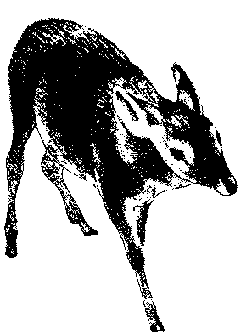
PUDU
The pudu (pronounced "poo-doo") is native to temperate forests of the Andean region. It is among the smallest of all true deer, adult males being merely the size of small terriers and the females being smaller still. It is very shy and retiring and is endangered.
All things considered, this animal would appear to be an unlikely candidate for microlivestock. But wherever it is found, the pudu is mercilessly hunted, and captive rearing might be the only way to save its populations from extinction. Indeed, it is already being raised in experimental herds in Chile and Argentina.
Pudus (also called the Andean dwarf deer) once ranged widely through the foothills, valleys, and lowlands of the Andes. They prefer the dark, dank underbrush of the cool rainforest, particularly thick bamboo stands. There are two species: Pudu pudu is distributed in parts of southern Bolivia and throughout much of southern Chile nearly to the Straits of Magellan. It is also found on islands off the Chilean coast. Pudu mephistophiles is distributed throughout the highlands of Ecuador, where it occurs only in cool areas at great height.
With their short legs, stocky bodies, and compact heads, pudus do not look much like deer - more like small antelopes with foxlike faces and spiky antlers. Full grown, they are only 40 cm tall and weigh less than 12 kg. They have thick fur ranging from reddish brown to pale gray.
Because of the pudu's small size, shy and secretive nature, and forbidding habitat, few people have ever even seen one. Nonetheless, these animals tame easily and reportedly were once kept by South American Indians. Several generations were also once bred in a Paris apartment and were treated exactly like domestic dogs, which most people who saw them for the first time thought they were.'
In recent years, habitat destruction has greatly reduced the range and numbers of these attractive and fascinating little creatures. The International Union for the Conservation of Nature already lists them as vulnerable to extinction. Pudu studies are highly recommended, and raising pudus promises to be an interesting and valuable activity that may one day lead to one of the most intriguing microlivestock of all.
BROCKET
Brockets (Mazama spp.) are small deer that occupy the place in South America's environment that duikers occupy in Africa (see page 326). They typically reside in thick brush. They occur widely throughout South America and are found in every country except Chile and Uruguay. They also occur in Central America, the West Indies, and Mexico.
There are four species:
- Red brocket (Mazama americana), the most common and widespread, is found from Mexico to Argentina. It is also the largest species, with a mature weight of about 20 kg.
- Gray (brown) brocket (Mazama gouazoubira) is also found throughout Latin America. It is slightly smaller, weighing about 17 kg.
- Lesser brocket (Mazama rufina)2 resides in small and scattered locations in Venezuela, Ecuador, Peru, Bolivia, Brazil, Argentina, and Paraguay. It weighs 10-20 kg.
- Dwarf brocket (Mazama chunyi) is found only in pockets of forest and brush on certain mountainsides in Venezuela, Colombia, Ecuador, and northern Peru. The smallest brocket, it weighs only 8-12 kg.
Except for their size and color, all brockets look alike. The head, neck, and tail are short; the ears are wide. The lumbar region is higher than the shoulders, and this, together with an arched back, gives them a hunched appearance not unlike a duiker's. The antlers are simple spikes, never longer than a person's hand.
The different species are similar in behavior, too.3 They generally wander around singly or in pairs. Although frequenting dense cover during the day, they emerge at night to feed in open areas. Little is known of their food preferences. But farmers know only too well how fond they are of melons, beans, peppers, and corn. Doubtless, wild forest fruits dominate their native diet.
Although extensively hunted, brockets are so adept at dodging into dense brush that relatively few get caught. However, small size makes them vulnerable to many other predators: puma, jaguar, ocelot, and eagles and other large birds of prey. Near villages the domestic dog is probably their worst enemy. (Infuriated vegetable growers commonly set their dogs on them.)
Although at first sight these retiring, nervous, and agile creatures seem unlikely to be even potential microlivestock, young brockets are sometimes caught and raised by people. It is not uncommon to find them as pets on farms and in gardens. They seem to become very tame and might therefore make useful livestock at some future time. At least one species, the grey brocket, adjusts particularly well to life in and around human settlements.
HUEMUL
The third type of South American microdeer, the huemul,4 is a much less likely candidate. It is very rare, very shy, and has so far shown little likelihood of settling into captivity. However, huemul conservation is critical: without urgent attention, the animal will become extinct. Although totally protected by law, it is declining owing to poaching, farm dogs, habitat loss and diseases transmitted by cattle and other livestock.
There are two species:
- The Chilean huemul (Hippocamelus bisulcus)5 occurs in high altitude forests, thickets, and grasslands in the Andes of southern Chile and Argentina.
- The Peruvian huemul, or taruca (H. antisepsis), occurs in parts of the Andes of southern Peru and Bolivia as well as of northern Chile and Argentina.
Both species live in small herds above the tree line. They are very shy, and even though the Chilean national seal bears the depiction of a huemul, almost no Chilean (or anyone else, for that matter) has ever seen a live one.
At less than 85 cm tall and probably weighing under 15 kg, huemuls are sized to be microlivestock. However, previous attempts at rearing them in Chile have met with little success. Nevertheless, huemuls have been kept in zoos in Germany, and such experiences - together with the increasing knowledge of how to raise red deer and other species - may eventually provide the keys to their continued existence.
30 Water Deer[edit | edit source]
Little is known about the water deer' (Hydropotes inermis), but it should be considered along with mouse deer, muntjacs, musk deer, and others as a possible species for microlivestock development. It is comparable in size, and it is unusual among deer for producing large litters: births of triplets or more are common.
As with the other species in this section, this is a highly speculative notion; however, there is some justification for it. The Zoological Society of London has successfully established breeding colonies, and other zoos have also bred the animal in captivity. The water deer has the advantage of rapid growth, early maturity, and high fecundity. Indeed, given protection, its populations have been known to increase rapidly.
APPEARANCE AND SIZE
The animal has a graceful and delicate appearance, its best known characteristic being the male's long tusks. Both sexes are about the same size, standing 45-55 cm at the shoulder and weighing up to 19 kg. Body length is up to about I m, and the tail is so tiny that it is barely noticeable. The round-tipped ears are characteristically held erect above the head.
Water deer are somewhat like muntjacs, but they are longer in the leg and lighter in build. Their forelegs are shorter than their hindlegs so that they stand slightly higher at the haunches than at the shoulders. This gives them a hunched appearance.
The hair is generally thick and coarse, longest on the flanks and rump. The backs and sides are usually yellowish brown, finely stippled with black. In winter, the coat is thick and variable in color; pale fawn and peppery gray-brown are common shades. In summer, the coat is sleek and reddish. Fawns are white spotted at birth, but this dappling soon fades.
Neither sex has antlers. The upper canine teeth, especially in the males, are enlarged, forming curved tusks 7 cm long. These are much bigger than those in muntjacs and can protrude well below the jawline.
In both sexes there is a small inguinal gland present between the hind legs, the only instance among deer.
DISTRIBUTION
In China the water deer has a wide distribution range. It is mainly found in the provinces of Jiangsu, Zhejiang, Anhui, Jiangxi, Hunan, Hubei, and Fujian, the mid and lower Yangtze River Basin, and coastal areas and islands in central and eastern China. It is also found in Guilin, southern Sichuan Province, Guangxi Province, and Guangdong Province in the south.2
In Korea, the animal lives along the lower reaches of most rivers, except those in the extreme northeast. Its northern limit of distribution is probably about latitude 43°N.
At Woburn Park in England, a few escaped from a herd early this century and have increased and become established in a number of counties, particularly Bedfordshire, Hertfordshire, Cambridgeshire, and Norfolk.
STATUS
In China, owing to increasing reclamation and cultivation of wetlands, the habitat of the water deer is gradually shrinking. At present the animal is protected by the government, which designates appropriate hunting seasons. It is estimated that about 10,000 are killed each year by hunters. In Korea the water deer is still plentiful. As noted, in England it is maintaining itself and is thriving in some protected parks. It is also reported to be present in France.
HABITAT AND ENVIRONMENT
In its home range, the water deer is usually found among reeds and rushes in swampy areas. It also frequents the tall grasses and sparse shrubs of mountainsides and cultivated fields. In England it has adapted to a variety of habitats, including woodlands.

BIOLOGY
The water deer is chiefly a grazer. It feeds mainly on reeds, coarse grasses, and some tree leaves.
As previously mentioned, this is the most prolific species of deer. Up to seven fetuses have been observed in a single pregnant female, although the normal litters are two or three. The gestation period is about 176 days. Fawns are born in late spring or early summer, and weigh only about 0.5 kg at birth. Within 4 days the newborns can live almost exclusively on grasses. Usually, however, they are fully weaned after 4 8 weeks, but remain socially attached to the mother. They appear to become independent after about 4 months. Males become sexually mature at about 5-6 months; females at about 7-8 months.3
BEHAVIOR
Water deer are generally seen alone. Even where abundant, they seldom congregate in herds. Females are sometimes intolerant of each other, as are adult males or young males. However, in captivity, several females can graze and rest in loose aggregations. The peak period of grazing activity occurs around dusk. Feeding sessions are interspersed with periods of passive cud-chewing.
Water deer "bark" at intruders. During the rut, males are especially noisy and aggressive, and defend their territories with vigor. Fighting involves striking their tusks into the shoulder or back of their opponents. 3 Information from Lu Houji. These are extremely excitable little animals. When upset, they often "hump" their backs and bound away like rabbits. They are also good swimmers.
USES
In China the water deer are hunted for their meat and skins, and newly born fawns are killed to obtain the mother's colostrum for medicinal purposes. In a few localities in England, the species has become a game animal.
HUSBANDRY
The water deer is not yet known on "farms." However, it seems to be easily kept, has bred well in zoos, and has thrived in many British wildlife parks.
ADVANTAGES
The assets of early maturity and high fecundity mean that the potential exists for rapid population expansion. Such an event occurred at Britain's Whipsnade Zoo. In 1929 and 1930, 32 deer were released into undeveloped pasture; by 1937, 120 fawns had been raised.
Because they are relatively small, and because in the wild state they aggregate only under exceptional conditions, water deer are unlikely to have any appreciable impact on vegetation in forests, farms, or gardens. Nonetheless, they can damage crops, and Chinese farmers, who consider them pests, often illegally kill them out of season.
LIMITATIONS
These animals are swift and adept at escaping captivity. It is possible that because of territoriality only a single pair will live in a given area. Moreover, males are aggressive and must be kept apart.
They seem able to withstand chilly weather well, but a combination of wet and cold is harmful. Their heavy winter coat, essential to survival in the Far East, renders the animal susceptible to dehydration and heat exhaustion in comparatively mild climates, such as England's.
At birth, the tiny fawns are extremely vulnerable to a variety of predators, both birds and mammals. The species may need areas of dense cover or some shelter from wind.
RESEARCH AND CONSERVATION NEEDS
The water deer has been successfully kept in semicaptivity for many years; however, for it to reach a level of domestication suitable for use as microlivestock, research is needed in the following areas:
- Reproduction;
- Performance under a range of environments;
- Grazing efficiency;
- Basic physiology;
- Captive breeding and domestication - measurements of growth rates, space requirements, and feed needs; and
- Modifying behavior to overcome territoriality - for instance, imprinting on humans, selection of docile specimens, hand rearing, and castration.
The water deer is not an endangered species; however, efforts should be made to preserve the populations in their native ranges and habitats.
31 Duikers[edit | edit source]
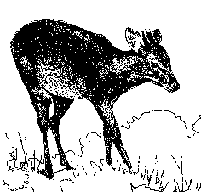
Duikers (Cephalophus and Sylvicapra species) are small African antelopes. Although they are ruminants like cattle, sheep, and goats, some are hardly bigger than hares or rabbits. One, the blue duiker, is less than 40 cm high and usually weighs a mere 4-6 kg. It and some of the slightly larger duikers might be suitable for household husbandry because their meat is an extremely popular food throughout much of Africa. In West Africa, for example, it is one of the most common meats sold in both rural and urban markets.
This idea, however, is highly speculative because, despite their popularity, little is known about these tiny animals. Their husbandry has been attempted only a few times, but the results were encouraging, and rearing duikers deserves further investigation. They are already being raised in captivity in the United States,' Zimbabwe,2 Togo,3 and Gabon. Researchers in Nigeria have bred blue duikers to the fourth generation and found that, if the animals were first handled by people while young, they remained docile.4 Even blue duikers caught in the wild tame quickly if they are very young, but by the time they reach 3.5 months, they become barely tolerant of man's presence.
If duiker husbandry can be developed, it might provide not only a more regular source of meat, but also a lessening of the hunting pressures, thereby giving the wild populations a better chance of survival.
AREA OF POTENTIAL USE
These antelopes are suitable for testing as microlivestock only in their native region, sub-Saharan Africa. Eventually, they might prove to have wider applicability.
APPEARANCE AND SIZE
Duiker species vary from about the size of a small dog to that of a small donkey. Most are similar in shape and are characterized by short front legs, arched back, and pointed hoofs. The tail is stubby, often with a terminal tuft. The coat varies from reddish brown to nearly black, although a few species are blue-grey and one is zebra striped.
Females are slightly larger than males, but the sexes look alike. In most species, both sexes bear small straight horns that project backward from the skull, frequently hidden in a long tuft of hair.
DISTRIBUTION
Duikers inhabit virtually all regions of Africa below the Sahara- from Gambia in the west to Ethiopia in the east, and all countries as far south as South Africa.
STATUS
Duikers are so shy that they are rarely encountered by people. But almost anywhere in Africa (other than North Africa), the observant traveler may glimpse them ducking into forests or thickets. Although there are still countless numbers, people are eating so many that in some localized areas the populations are fast heading toward extinction.
HABITAT AND ENVIRONMENT
All but one species are found in rainforests or dense woodlands. The grey duiker, however, is found in savannas. If the vegetation is juicy, only a few of the species need a separate water source, so they can thrive in very dry sites.
BIOLOGY
The main foods are fruits and seeds supplemented by leaves and shoots. Fruits, which they eat to a much greater degree than other antelopes, are an important part of their diet. Some rare species (for example, the red-flanked duiker, C. rufilatus) can graze. Occasionally (especially in captivity), duikers are also omnivorous, eating fish, crabs, insects, snails, frogs, small animals, or carrion; they also readily accept chopped meat.
Duikers reach sexual maturity at 9-15 months; gestation lasts about 7-8 months. In some species, females conceive a few days after calving on a 3- to 5-day postpartum estrus. Apparently one calf per birth is normal. A newborn blue duiker weighs between 0.4 and 0.7 kg.
Before one year of age, young duikers leave their parents to find their own mates and territories. Life expectancy is more than 10 years.
BEHAVIOR
In spite of habitat differences, most duikers behave alike. In the wild they are nervous, shy, and retiring. When alarmed, they plunge into the protection of dense vegetation - hence the origin of the name duiker, which means "diver." Nonetheless, their behavior allows them to be easily netted. An experienced hunter can imitate duiker sounds and call the male out of the bush. Also, a startled animal freezes, thereby facilitating its capture.
Moving easily through dense vegetation, the head carried low, these tiny animals use regular runs. Forest duiker species are largely diurnal, although a few, such as the bay duiker, are nocturnal. Bush duikers are mainly nocturnal, feeding from early evening until morning. Such nocturnal species shelter during the day in holes (presumably dug by other animals) or inside fallen trees; the diurnal ones lie directly on the ground.
Blue duikers are the best-known species and are probably the most likely candidates for microlivestock (see page 332). They seem to be monogamous and apparently mate for life. Unlike most antelopes, their population densities can be high. The pairs reside in territories of 2-4 hectares, which both male and female stoutly defend against rivals. Other species appear to be polygamous and live in large territories (up to 80 hectares).
In captivity, the animals are generally calm. However, both males and females can be aggressive toward unfamiliar individuals of their own species. In an enclosure, one male can serve several females.
Large glands, located beneath each eye, exude a scent that is rubbed onto fences, trees, and other objects as territorial marking. In another form of marking the horns are rubbed against tree trunks.
USES
As noted, duiker meat is much sought in many African countries, and the animals are regularly hunted. The meat is lean with little or no intramuscular fat (marbling).
Duikers also have promise as experimental animals. They are true ruminants, with four-part stomachs, and they produce cud. Some are only rabbit size, they need far less room or feed than sheep, and thus are potentially an efficient test animal for determining the nutritional value of forages. Blue duikers, for instance, have a digestion efficiency comparable to that of sheep, but, because of their small size, a test needs only four rabbit cages and 5-10 kg of feed. Sheep, by comparison, require much more spacious facilities and 150 kg of feed.
In Nigeria, blue duiker pelts are used in making karosses, a traditional dress. A single garment may contain up to 60 pelts.
HUSBANDRY
Almost nothing is known about rearing duikers, but they seem to tame easily and perhaps may be kept in backyards like goats. Indeed, they reportedly make good house pets when hand raised. They are attractive, and from the day of capture young ones can be handled and petted.5
The Nigerian researchers who bred blue duikers to the fourth generation bottle-fed young specimens five times a day. Older animals were given feeds that included banana, plantain, and papaya; leaves of hibiscus, cassava, and banana; and dried corn. Variety seemed to be important, and the researchers could not predict the quantity of particular foods the animals would choose on any given day. In addition to varied vegetables, a small dish of salt or a salt lick was sometimes required.6
Duikers are unlikely to run away, except when startled. However, providing an enclosure is worthwhile. It enables them to establish a territory by marking poles, bushes, and fences. Although needing space in which to run, as little as 10 m° is reportedly sufficient for 24 animals.
Satisfactory shelters include an open-ended oil drum laid on its side, a lean-to made of palm frond, or a small hut made of local matting. Apart from providing shade and protection, shelters should be built so that excited animals can run through them. When cornered, duikers tend to either flee for shelter or jump upwards; a run-through shelter can prevent a frightened one from accidentally leaping over the fence.
Based on their own experiences, researchers at Pennsylvania State University in the United States report that blue duikers raised in captivity are easy to maintain, reproduce well, and are not fussy about environmental conditions. In fact, they say, blue duikers seem to enjoy living in cages.7
In order to raise duikers successfully, post-pubertal males must be separated. A female should be bred with the same male throughout her productive life span.
THE BLUE DUIKER
In one sense, the blue duiker is the most important animal in Africa. It is the only one found throughout the continent south of the Sahara. It occurs at a greater range of altitudes than most - as low as sea level in many places to almost 5,000 m elevation in Kenya. It occurs in habitats from dense rainforests to dryland savannas. And, in sub-Saharan Africa as a whole, the blue duiker is eaten more than any other animal (although in West Africa it is generally called Maxwell's duiker).
This very small antelope, caught by snare or net, can be found in the meat markets of villages, towns, and cities in all countries from Senegal to Madagascar. It is a source of food for tens of millions. Bushmen, Pygmies, Dinkas, and Mandingos, thousands of miles apart; all share the same fondness for duiker meat and for duiker-skin clothes.
Nevertheless, scientifically speaking, this is one of the world's least-known animals. And its numbers are diminishing rapidly. Areas that used to have plenty now have few or none. Overhunting and destruction of the rainforests are jointly contributing to their decline.
Despite the losses, people are snaring as many as they can, and there is no sense of concern - not even among most conservationists. However, in many locations there is already evidence that the animals won't be around much longer. Unless something is done - and soon - people will lose their major source of animal protein. If that happens, it is likely that they will move on to larger animals, such as gorillas, which would be an even worse disaster.
The best long-term solution is to organize duiker husbandry. Learning to rear duikers would benefit people throughout Africa. The blue duiker is the most suitable species; it is the most common and the most important. Also, it inhabits the edges of the forest and could therefore become a suitable species for ranching without denuding the forest.
Blue duikers are easy to maintain in captivity. They tame readily and like to shelter and sleep In boxes or cages. They are good converters of vegetation and produce top-quality lean meat. In addition, they are neither affected by tsetse flies nor are very susceptible to diseases.
The key now is to learn how to keep these very timid creatures under different conditions. We need to know their foods (especially foods that might be harvested from forests) and reproductive biology. We need to know the right numbers to house together. Most of all, we need projects aimed at rearing and breeding them in captivity under village conditions.
Vivian J. Wilson
ADVANTAGES
Many African countries already have a ready market for duiker meat. It is somewhat similar to goat meat, but most people agree that it is superior.
The animal can live on fibrous vegetation. Unlike conventional ruminant livestock, it is suitable for feeding an average family at one meal.
The ability to forage in undergrowth where other domestic livestock do not thrive makes duikers potential livestock for tropical forest and bushland regions. They can be raised for meat without cutting the trees or bushes to create pastures.
LIMITATIONS
Duikers are easy prey for predators: eagles, pythons, wildcats, and people, among others. Thus, they probably require more sophisticated management than common livestock such as goats. However, the quality of their meat could more than compensate for the extra effort.
Some species are territorial, which means that they may do poorly in captivity, unless their social organization can be altered.
Under good conditions, the ideal slaughtering age reportedly occurs at 8-10 months, when the blue duiker can weigh 4 kg. Compared to rabbits and guinea pigs, production is relatively slow because of long gestation and lack of multiple births.
Duikers are resistant to trypanosomiasis.
One general problem is that duikers have short, sharp horns designed specifically for jabbing. This could be a potential danger, especially since the males of some species become aggressive when their females are receptive. However, the horns can easily be clipped and taped to limit the danger.
RESEARCH AND CONSERVATION NEEDS
Because of the duikers' secluded lifestyle, much has still to be learned about their habits. Specific information on behavior and breeding is needed.
Animal scientists in Africa should gather small herds for comparative studies. This will provide insights into whether duiker temperaments facilitate or hinder their utilization. In addition, assessments of diet, growth rates, behavior in captivity, reproductive rate, adaptability, and future potential can be made. Management considerations include clipping horns, trimming hooves, and controlling lice and fleas.
Research of particular value would be chemical analysis of duiker milk and of other characteristic glandular secretions. The latter lend themselves especially to a study of animal communication.
Parming duikers might help rescue the wild populations by relieving hunting pressures. Programs in this area are recommended for locations where overhunting is occurring.
32 Other Small Antelope[edit | edit source]

The least known and most obscure of all antelope are the delicate African creatures called dikdik, suni, royal antelope, pygmy antelope, and klipspringer. The smallest is a West African form of the royal antelope that stands a mere 25 cm high and weighs less than 2 kg. The four-horned antelope of South Asia is a similarly tough, tractable animal that is also the size of a small dog.
None of these has previously been seriously considered for use as livestock, but they are possibly amenable to rearing in captivity and they provide some of the finest game meat in the world. Given New Zealand's experience with various deer species (see page 288) and Africa's experience with large antelopes, basic research to test out the possibility of organized dwarf-antelope production could prove to be rewarding.
AREA OF POTENTIAL USE
The areas where these antelopes might be used are sub-Saharan Africa for the African species and South Asia for the four-horned antelope.
APPEARANCE AND SIZE
Of these animals, some, such as the pygmy antelopes, have a crouched appearance with an arched back and short neck; others have a more upright posture with a long neck and a raised head. In all species, the males are smaller than the females and bear tiny spikelike horns.
DISTRIBUTION
Collectively, these antelopes have native ranges covering huge areas of Africa and part of Asia.
Dikdik: Six species occur in two discontinuous distributions - one from Somalia and Ethiopia southward through Kenya and Tanzania, the other in Namibia and Angola.
Sunis: Eastern Africa, from Kenya to South Africa.
Royal antelope: West African forests.
Pygmy antelope: Central Africa from southeastern Nigeria to Zaire.
Klipspringer: Ethiopia to the Cape of Good Hope.
Four-horned antelope: India.
STATUS
Many forms are protected by local laws, but none of the species is on the international endangered-species list.
HABITAT AND ENVIRONMENT
The animals occupy habitats from dense, moist forests to dry, rocky outcrops and even to deserts. Their ranges have almost certainly been affected by humans - sometimes for the better, since many prefer the secondary growth that invades disturbed areas, notably after overgrazing or slash-and-burn agriculture.
Although dikdik and klipspringer usually frequent dry areas with scattered brush, the other dwarf antelopes normally stay in dense vegetation. All seem to live in definite areas and do not migrate. For instance:
- Dikdik live near streambanks.
- Sunis inhabit dry country with thick bush, but they can also be found in reed scrub along rivers and in forests up to 3,000 m elevation.
- Klipspringers live on stony mountain slopes, rocky outcrops' or the sides of steep gorges at altitudes from sea level to 4,000 m.
- Four-horned antelopes live in undulating or hill country and shelter in tall grass and open jungle, a terrain more common to deer than to antelope.
BIOLOGY
Most of these antelope browse on shrubs. They are "concentrate selectors," taking easily digested vegetation such as buds, fruit, and succulent young leaves.
Also, most obtain much of their water requirement from dew and the vegetation they consume. Klipspringers, for example, are able to live for months without drinking. Sunis and four-horned antelope, on the other hand, drink regularly and seldom live far from water sources.
Little is known of the reproduction and general performance of these animals. Females become sexually mature at about 6 months in the smaller species and 10 months in the larger. Males become sexually mature at about 14 months. The young are born throughout the year, but births peak with the vegetation flush following the first rains. Where there are two rainy seasons a year, two birth peaks occur. Usually a single calf is born. Dikdik is the only one whose reproduction has been studied in detail. Its pregnancy lasts 172 days, one young is born at a time, and the birth weight is 600-800 g.
Their longevity is unknown but is probably in the range of 10-12 years.l
BEHAVIOR
These tiny creatures have some of the habits of deer. They are shy and elusive and generally rely on concealment to escape detection. Their first response to a predator is to freeze, and then to flee like hares - dashing off in a series of erratic, zigzag leaps.
They live alone, in pairs, or in small family groups, but sometimes congregate in larger groups in thorn thickets. The species that have been studied most (dikdik and klipspringer) are strongly pair bonded. (A male, a female, and one or two young is typical, and a klipspringer rarely moves more than 5 m from its mate.) However, the royal and pygmy antelopes and the suni are more solitary in their behavior. Four-horned antelope are usually seen alone or in pairs.
These animals feed mostly in the early morning and late afternoon Some species deposit dung and urine on particular sites. And they repeatedly daub secretions from glands in front of the eyes onto plant stems, where a sticky mass accumulates. Glands near the hooves mark the ground along frequently traveled pathways. Males also mark females with the scent, thus reinforcing the bond.
The four-horned antelope has a whistling call, which helps keep the family group together. Males repeat it frequently in hot weather. Gestation is 8-8.5 months. If taken young, they reportedly tame easily.
HUSBANDRY
Much more research needs to be done before attempts are made to convince anyone to domesticate these antelope. There are likely to be considerable difficulties. Guinea pigs, rabbits, and giant rats can successfully be kept in cages or small enclosures, but most antelope probably cannot. Larger enclosures will be needed.
The food habits and general behavior of these small animals must be studied closely. They are strictly monogamous, and it may be necessary to keep them in pairs. Reproduction, growth, and general performance must become understood under different environmental and nutritional conditions. Mixing species is another aspect to be examined - whether these antelope can be kept with other species in the same enclosure (typical of livestock farming in most poor nations) is not known.
To settle such questions, representative species of microantelope should be gathered for comparative assessment. Researchers should focus on the animals' social structure, on husbandry methods for maintaining them over generations, and on how best to breed them. If the findings are promising, then a campaign to domesticate these antelope could be mounted.
USES
Throughout most of their ranges these animals are highly sought "bushmeats." The meat is lean and of extremely high quality. In Zaire's Ituri Forest, for example, pygmies net and kill large numbers of pygmy antelope, hanging the carcasses on sticks by the roadside for sale.
Because of their small size, these species might make good laboratory animals for ruminant studies. The dikdik, for instance, becomes a fully functioning ruminant at a body weight of about only 1.5 kg.2 However, their digestive physiology is quite different from that of cattle, sheep, and goats, which makes them atypical ruminants.
Given organized production, it is likely that dwarf-antelope pelts could become commercially important. North Africa exports the hides of medium-size antelopes to Europe for use in fine sueded leathers. Hides of the small species would almost certainly be in demand as well if a steady supply could be obtained as a by-product of meat production.
ADVANTAGES
Microantelope provide some of the finest game meat. They are small and perhaps tractable. Most are already widely eaten and are being eliminated over broad areas of their range. Turning them into a sustainable, economic food source could provide motivation for their conservation.
These antelope can digest, and are adapted to, the indigenous forage over vast areas of Africa and South Asia. They are native to tropical habitats, where cattle and other livestock often grow poorly. They also appear to be resistant to trypanosomiasis.
LIMITATIONS
Some African peoples (for example, the Kalahari Bushmen) have superstitions or social injunctions that prohibit the eating of some of these species.
Small antelope are probably not as efficient as larger ruminants in digesting fiber: the retention time in the rumen may be too short. On the other hand, quickly digestible cell walls of lush green plants can be used efficiently.3
The territorial behavior of most of these species may limit their rearing in large numbers under captive conditions.
RESEARCH AND CONSERVATION NEEDS
As noted, preliminary research on dwarf antelope husbandry is required. Specifically, studies should be conducted to assess:
- Growth rates, feed efficiency, and reproductive rate;
- Carcass quality;
- Economics and the likely cost of production per animal unit; and
- Studies of digestion.
4
The few statistics available today on the use of wildlife as food are probably much below actual consumption. Most food consumption surveys record food obtained by hunting or trapping under the indiscriminate heading of "Bushmeat" and neglect to include the many small animals that are normally collected by children. In Africa, an amazing variety of wildlife is eaten, including all wild ungulates, primates, all cats, and many species of birds and reptiles. Food and Agriculture Organization Ceres magazine
All the world's people must begin to overcome in themselves - and even more so in their children - senseless taboos about what is edible and what is not. Only then can we stop today's universal animal-protein wastage. How ironic it would be, in this scientific age, for mankind to starve largely because of a bunch of old wives' tales, irational beliefs, silly associations, and the lack of a sufficient spirit of culinary and gustatory adventure. Calvin W. Schwabe Unmentionable Cuisine
Iguana is really good, a thousand times better than chicken. Omero Asinto, waiter Pochote Bar and Restaurant Barranca, Costa Rica
dsfgdsfgdsf
